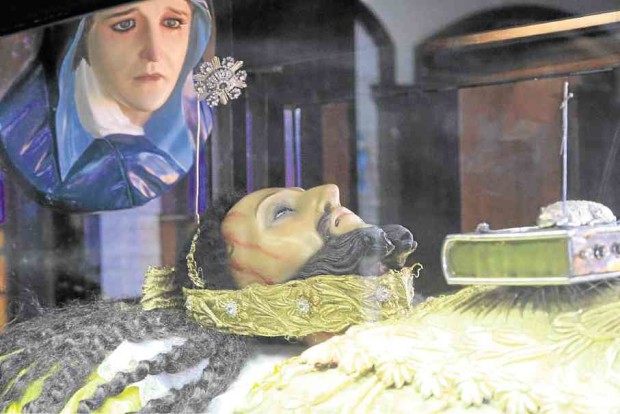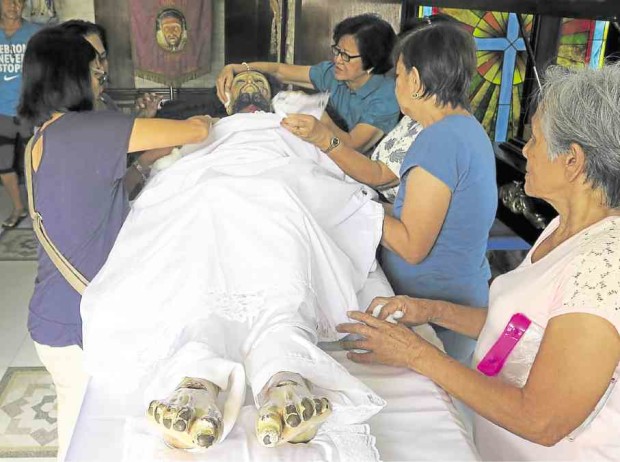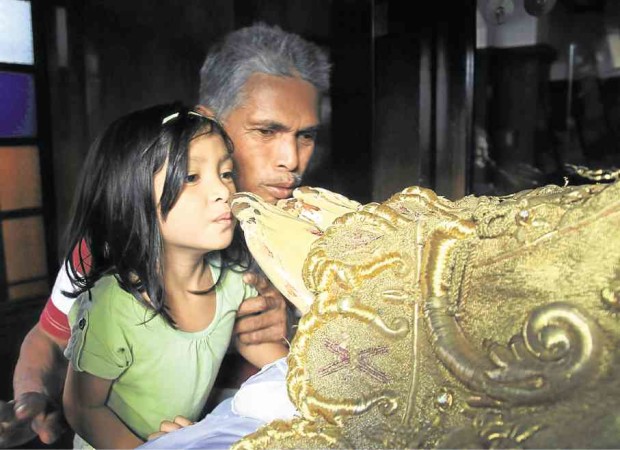Faith draws multitudes to Lucban

DEVOTION The procession of “Mahal na Señor” in Lucban, Quezon, attracts devotees who fulfill their vow on Good
Friday. —PHOTOS BY DELFIN T.MALLARI JR.
Lucban, Quezon—It’s all about faith.
Every Good Friday, hundreds of thousands of people would line up to get inside a two-story structure here housing a centuries-old revered image of Jesus Christ just to kiss or touch its feet.
The structure, “Tahanan ng Mahal na Señor” (Home of the Beloved Lord) and home to the image of a dead Christ called “Santo Señor Sepulcro,” becomes the focal point of Holy Week pilgrimage in the town.
Local Church officials see the same kind of faith that draws millions to Quiapo in Manila for the Black Nazarene feast at work in the Tahanan.
“If Quiapo has Poong Nazareno, in Lucban we also have our own ‘Mahal na Señor,’” said Fr. Noel Cabungcal, parish priest of San Obispo de Tolosa church here.
Article continues after this advertisementThe Good Friday procession featuring the image of the Señor is the most anticipated Holy Week event in Lucban.
Article continues after this advertisement“It attracts devotion even from outside of Lucban. They regularly come during Good Friday to join the procession,” Cabungcal said.
Fr. Joey Faller, renowned healing priest who administers the Kamay ni Hesus (Hand of Jesus) shrine in the town, described locals as “very religious” people.
Collective faith
“Our collective faith and devotion to our ‘Señor’ is reflective of this heart-warming trait,” he said.
In Quezon province, Lucban is known as leading producer of Catholic priests.
Devotion to the Señor grew over the years.
Jayson Maceo, who lived as a child at the Señor’s house, said the family of Juan Rañola and his son, Tomas Pacifico, reclaimed the religious icon which was pawned for 800 peso reales (former Spanish unit currency after the mid-14th century) by its original owner to a wealthy businessman in Sta. Cruz, Manila sometime in 1895, based on a Spanish court record.
“The Rañolas brought the Señor back to Lucban to continue its role in the town’s Holy Week tradition,” Maceo said.
The image, believed to have been made between the late 1700s to early 1800s, survived bombings by the Japanese during World War II because locals hid it, moving it from farm to farm, according to local historians.
Every Good Friday morning, women devotees would clean and dress the Señor before male devotees carried it to the church for the afternoon procession. Cotton balls used in cleaning the image are collected for its supposed miraculous properties.
Rituals
The Señor’s gold blanket, covered with embroidered biblical symbols, was made by the ancestors of Jaro Archbishop Angel Lagdameo, also a Lucban native, sometime in late 1800. The blanket is kept in an antique wooden case and is taken out only during Holy Week.
Outside, devotees chant the Pasyon (Passion of Jesus Christ).
On Good Friday, pews inside the parish church are removed to accommodate more devotees.
The Señor, in a glass carriage, comes out of the parish church at 6 p.m. amid the rhythmic clapping of spliced bamboo poles heard all over the plaza. The Señor is the last of more than 30 religious icons in the procession.
Throngs of devotees, mostly clad in denim pants and white shirts painted with the image of Jesus Christ’s face covered in blood and wearing a crown of thorns, struggle to touch the ropes attach to the stainless carriage.
It is a scene out of the Black Nazarene feast enacted some 123 kilometers from Quiapo.
Devotees walk barefoot ahead of the carriage carrying lighted candles as they pray aloud.
In the earlier days of the procession, male devotees had to carry the glass carriage of the Señor on their shoulders.
Nobody could remember when ropes started to be used.
Alberto Daya, 80, said he bore the carriage on his shoulders as a high school student.
“It was my vow that I will carry his carriage as long as I can,” he said. He stopped doing it when age caught up with him.
Influence of alcohol
Many devotees join the procession intoxicated, wrongly professing that alcohol helps them endure the ordeal of carrying the Señor’s carriage on their shoulders.
It is a practice shunned by the Church and other devotees, however.
Faller said carrying the carriage was a “sincere expression of the faith.”
“A devotee should fulfill the vow of sacrifice and penitence in the most solemn way,” Faller said.
“There should be no unwelcome influence during the rite,” he added.
In 2007, a group of 75 devotees organized the “Deboto ng Mahal na Señor” to keep drunken men away from the procession.
“Drunk devotees are potential troublemakers,” said Marcialito Macasero, 38, one of the group’s organizers and head marshal during the procession.
Macasero and a couple of members of the group are the only devotees allowed to stay atop the carriage during the entire procession to serve as navigators.
Last year, the procession ended at the church at 2 a.m. on Black Saturday, or after eight hours of winding its way through the town’s narrow roads.
After the procession, most devotees struggle to get a piece of the nylon rope used in pulling the carriage, believing pieces of it could cure diseases, bring good luck, protect them from harm, bring good health and deliver miracles.
After the procession, the carriage of the Señor is returned to its home, the Tahanan, by women devotees only.
RELATED VIDEO


